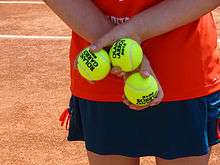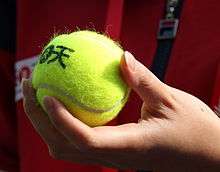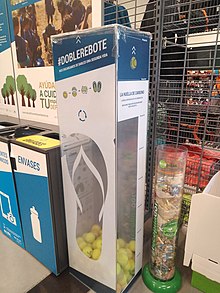Tennis ball
A tennis ball is a ball designed for the sport of tennis. Tennis balls are fluorescent yellow at major sporting events,[1][2] but in recreational play can be virtually any color. Tennis balls are covered in a fibrous felt which modifies their aerodynamic properties, and each has a white curvilinear oval covering it.

Specifications

Modern tennis balls must conform to certain criteria for size, weight, deformation, and bounce criteria to be approved for regulation play. The International Tennis Federation (ITF) defines the official diameter as 6.54–6.86 cm (2.57–2.70 inches). Balls must have masses in the range 56.0–59.4 g (1.98–2.10 ounces). Yellow and white are the only colors approved by the ITF, and most balls produced are a fluorescent yellow known as "optic yellow", first introduced in 1972 following research demonstrating they were more visible on television.
Tennis balls are filled with air and are surfaced by a uniform felt-covered rubber compound. The felt delays flow separation in the boundary layer which reduces aerodynamic drag and gives the ball better flight properties.[3][4] Often the balls will have a number on them in addition to the brand name. This helps distinguish one set of balls from another of the same brand on an adjacent court.[5]
Tennis balls begin to lose their bounce as soon as the tennis ball can is opened. They can be tested to determine their bounce. Modern regulation tennis balls are kept under pressure (approximately two atmospheres) until initially used; balls intended for use at high altitudes have a lower initial pressure, and inexpensive practice balls are made without internal pressurization. A ball is tested for bounce by dropping it from a height of 254 cm (100 inches) onto concrete; a bounce between 135 and 147 cm (53 and 58 inches) is acceptable—if taking place at sea-level and 20 °C (68 °F) with relative humidity of 60%; high-altitude balls have different characteristics when tested at sea level.[6]
Slower balls
The ITF's "Play and Stay" campaign aims to increase tennis participation worldwide, by improving the way starter players are introduced to the game. The ITF recommends a progression that focuses on a range of slower balls and smaller court sizes to introduce the game effectively to both adults and children. The slowest balls, marked with red, or using half red felt, are oversized and unpressurized, or made from foam rubber. The next, in orange, are unpressurized normal sized balls. The last, with green, are half pressured normal sized.[5]
History

Before the development of lawn tennis in the early 1870s, the sport was played as the courtly game of real tennis. England banned the importation of tennis balls, playing cards, dice, and other goods in the Act of Parliament Exportation, Importation, Apparel Act 1463.[7] In 1480, Louis XI of France forbade the filling of tennis balls with chalk, sand, sawdust, or earth, and stated that they were to be made of good leather, well-stuffed with wool.[8] Other early tennis balls were made by Scottish craftsmen from a wool-wrapped stomach of a sheep or goat and tied with rope. Those recovered from the hammer-beam roof of Westminster Hall during a period of restoration in the 1920s were found to have been manufactured from a combination of putty and human hair, and were dated to the reign of Henry VIII.[9] Other versions, using materials such as animal fur, rope made from animal intestines and muscles, and pine wood, were found in Scottish castles dating back to the 16th century. In the 18th century, 1.9 cm (3⁄4 in) strips of wool were wound tightly around a nucleus made by rolling a number of strips into a little ball.[10] String was then tied in many directions around the ball and a white cloth covering sewn around the ball.
In the early 1870s lawn tennis arose in Britain through the pioneering efforts of Walter Clopton Wingfield and Harry Gem, often using Victorian lawns laid out for croquet. Wingfield marketed tennis sets, which included rubber balls imported from Germany. After Charles Goodyear invented vulcanised rubber, the Germans had been most successful in developing vulcanised air-filled rubber balls. These were light and coloured grey or red with no covering. John Moyer Heathcote suggested and tried the experiment of covering the rubber ball with flannel, and by 1882 Wingfield was advertising his balls as clad in stout cloth made in Melton Mowbray.[11]
Packaging
Before 1925, tennis balls were packaged in wrapped paper and paperboard boxes. In 1925, Wilson-Western Sporting Goods Company introduced cardboard tubes. In 1926, the Pennsylvania Rubber Company released a hermetically sealed pressurized metal tube that held three balls with a churchkey to open the top. Beginning in the 1980s, plastic (from recycled PET)[12] cans with a full-top pull-tab seal and plastic lid fit three or four balls per can. Pressureless balls often come in net bags or buckets since they do not need to be pressure-sealed.
Disposal

Each year approximately 325 million balls are produced, which contributes roughly 20,000 tonnes (22,000 short tons) of waste in the form of rubber that is not easily biodegradable. Historically, tennis ball recycling has not existed. However, in 2015 three companies (Advanced Polymer Technology, Ace Surfaces and reBounces) joined together to create a recycling system that incorporates recycled tennis balls into a tennis court surface.[13] Balls from The Championships, Wimbledon are now recycled to provide field homes for the nationally threatened Eurasian harvest mouse.[14] Other alternative available from 2013 is re-pressurizing them for reusage[15]
In literature
The gift of tennis balls offered to Henry in Shakespeare's Henry V is portrayed as the final insult which re-ignites the Hundred Years' War between England and France.[16]
John Webster also refers to tennis balls in The Duchess of Malfi.[17]
John Self in Martin Amis's novel, Money, is struck in the face by a tennis ball.[18]
References
- "ITF Technical - History". International Tennis Federation. Retrieved 4 June 2015.
- "Inside Wilson's tennis ball factory". ESPN The Magazine. 30 August 2015. Retrieved 2 November 2015.
- "Golf Balls, Cricket Balls and Tennis Balls". Princeton University. 5 October 2005. Retrieved 2009-10-20.
- Dr. Rabi Mehta of NASA-Ames, entitled Aerodynamics of sportsballs, Annual Review of Fluid Mechanics, 17:151–189, 1985.
- "Colors & Numbers on Tennis Balls". Epic Tennis Academy. Retrieved 2 September 2015.
- "ITF Technical - Approval Tests". International Tennis Federation. Retrieved 12 September 2014.
- Bell, R.C. (1981). Board and table game antiques. Osprey Publishing. ISBN 0852635389.
- Morgan, Roger (1995): Tennis, The Development of The European Ball Game, ISBN 0-9510251-8-X
- http://www.parliament.uk/about/living-heritage/building/palace/westminsterhall/architecture/the-hammer-beam-roof-/
- Cross, R. "Dynamic properties of tennis balls." Sports Engineering 2 (1999): 23-34.
- Heiner Gillmeister Tennis: a cultural history p177 on
- Recycling, PETRA (PET Resin Association), retrieved 21 July 2010
- , ASBA (American Sports Builders Association), retrieved 21 December 2015
- "'New balls, please' for mice homes". BBC News. Retrieved 6 November 2015.
- Dos emprendedores alicantinos lanzan la máquina de reciclar pelotas de tenis
- "When we have match'd our rackets to these balls, We will, in France, by God's grace, play a set" Henry V, act 1, scene 2
- "We are merely the stars' tennis balls, struck and banded/Which way please them" The Duchess of Malfi, act 5, scene 4
- "The ball came screaming over the tape, skipped a beat, regathered its tilt and momentum—and punched me in the face. I toppled over backwards and my racket fell with a clatter. For several shocked seconds I lay there like an old dog, an old dog that wants its old belly stroked."
External links
| Wikimedia Commons has media related to Tennis balls. |
- International Tennis Federation's history of the rules of the tennis ball
- ITF Grand Slam Rules:Section I:The Ball
